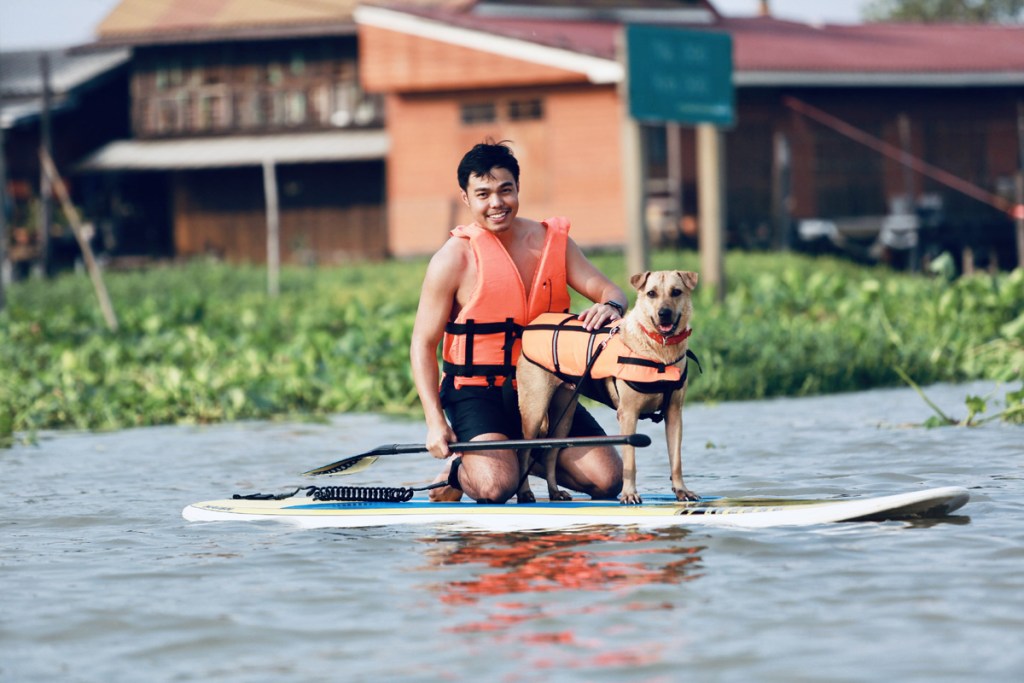According to the International Surfing Association, stand-up paddleboarding (SUP) is the world’s fastest-growing water sport. Enthusiasts can enjoy paddling on oceans, lakes, or rivers and for many pet parents, it’s only a matter of time before they take their dogs along for the ride. Many of these SUP pups have become Instagram hits. For example, Finley and Zeke (seen below) have more than 6,000 fans who are delighted by the photos and videos of these golden retrievers living it up on their paddleboards.
In a Kong article, Maria Christina Schultz, author of “How to SUP with your PUP” says that like people, dogs are drawn to this sport for the sense of peace and adventure. There are other benefits, too; it’s easy for dogs to get on and off paddleboards, giving them a greater feeling of freedom than when traveling in a kayak or a canoe.
How to teach your dog to paddleboard
There are a few things to consider before teaching your dog to paddleboard:
Will your dog enjoy the sport?
If your dog is nervous around water, he probably would prefer to join you on hiking adventures. According to a SUP Connect article, the six breeds that typically make great paddleboarding dogs are golden retrievers, Labrador retrievers, Portuguese waterdogs, Australian shepherds, Newfoundlands, and Australian cattle dogs. However, there are lots of other breeds who enjoy the water, and some paddleboarders report that their dogs don’t necessarily enjoy swimming but they love paddleboarding.
Do you have the right paddleboard for your dog?
You want your dog to be comfortable on the board so you need to choose wisely. Experts at Cruiser SUP say that the best paddleboards for dogs are at least 10-feet-long and 32-inches-wide. You also need a board with traction pads, or you can add pads to prevent your dog from slipping off of the board.
Do you have the necessary paddleboarding skills?
You need to be comfortable standing up, paddling, and turning before taking your dog out on a paddleboard. You also need to practice falling off and getting back on the board. According to experts at Cruiser SUP, “Dogs will mirror your stress if you are not comfortable, and being on a stand-up paddleboard with a dog in tow will only make things more difficult for beginners.”
Once you’ve mastered the necessary skills, follow these steps to teach your dog to paddleboard:
- Lay the paddleboard somewhere in the house where your dog is comfortable. Let her sniff the board and get used to being around it.
- Once your dog is comfortable, place a treat on the board and invite her to jump on to get it. Practice “sit,” “down,” and “stay” commands while your dog is on the board.
- Train your dog to only get off the board on your command. If she gets off on her own, guide her back onto the board and reward her. Gradually increase the length of time your dog lays or sits on the board.
- Get on the board with your dog. Kneel behind her and move the paddle as you would in the water. Once she’s comfortable with this, stand up and continue with the paddling motion.
- If all goes well, repeat these lessons outside with the paddleboard laying beside a body of water. As long as your dog is comfortable you can continue the lesson in the water.
- Hold the board in shallow water and invite your dog to jump on. Walk the board around offering lots of praise and treats to your dog.
- When your dog is comfortable on the board in the water you can hop on with him. Start by paddling while kneeling behind him and work towards standing up. If all goes well, after a few lessons, you can begin heading further out into the water. Always keep paddleboarding trips short in the beginning.
How to paddleboard safely with dogs
A lifejacket is a must
Your dog should always wear a life jacket even if he’s a strong swimmer. Be sure to choose one with a handle so you can easily lift your dog back onto the board if he falls off.
Bring a first aid kit
Always include a basic pet first aid kit in your attachable storage bag. And make sure to include dog-friendly sunscreen to protect sensitive skin.
Avoid dehydration
It gets hot out on the water. Always pack freshwater inside a paddleboard cooler pack and take along a collapsible bowl.
Be aware of ocean dangers
If you’re planning an outing on the ocean, be aware of the hazards. For example, sea lice can cause skin rash, jellyfish can sting, and hot sand can burn your dog’s paws. Always rinse your dog after an ocean outing to remove any salt or sand from his coat.
Be prepared as you approach the shore
Many dogs get excited as the paddleboard gets close to shore and may jump in the water. For safety reasons, Schultz recommends kneeling to make balancing easier once you’re within 15 feet of the shore or dock.

Finally, while you may be excited to have your dog join you on the water, you can’t rush the process. Some dogs learn new skills quickly while others need more time. If you push your dog past his comfort zone, he will end up fearing the paddleboard and you’ll both miss out on the opportunity to take exciting adventures together.



